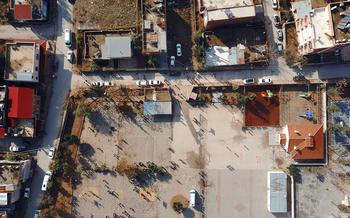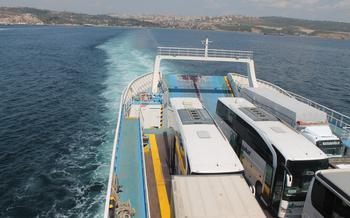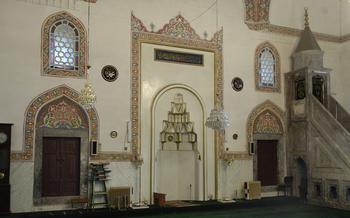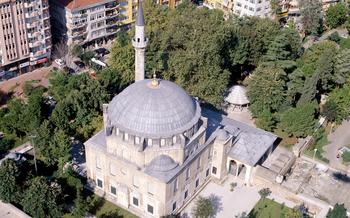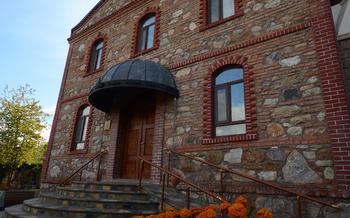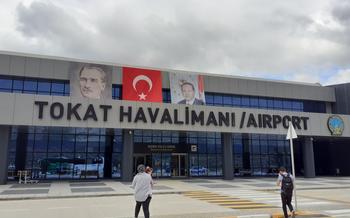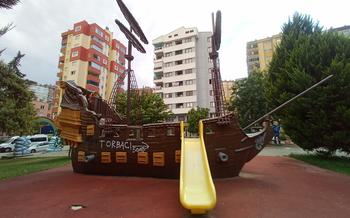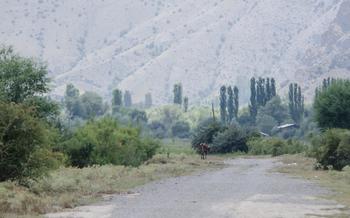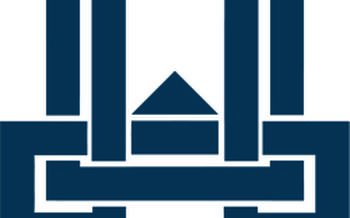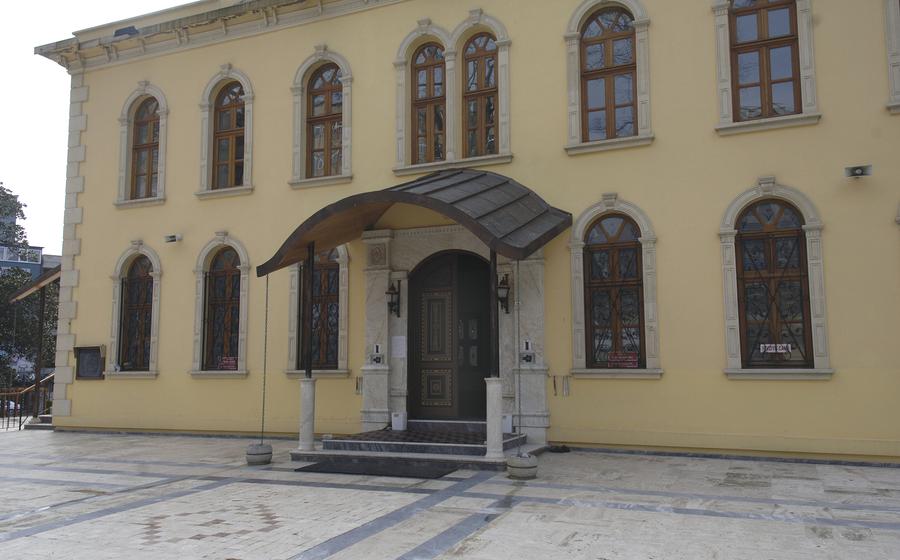
Fevziye Mosque
- The Fevziye Mosque: A Stunning Masterpiece
- Location and Accessibility
- Visiting Hours and Admission
- Exploring the Mosque's Interior
- Admire the Exterior Architecture
- Discover the History of the Mosque
- Experiencing the Call to Prayer
- Learn About Islamic Architecture
- Attend a Religious Service or Event
- Explore the Mosque's Surroundings
- Capture the Beauty Through Photography
- Local Customs and Etiquette
- Recommended Tours and Guides
- Combining History and Nature
- Insider Tip: Hidden Gem
The Fevziye Mosque: A Stunning Masterpiece
The Fevziye Mosque stands as a testament to the architectural prowess and cultural heritage of İzmit, Turkey. Built in the early 19th century, this magnificent mosque boasts a rich history and unique architectural features that have earned it a place among the city's most iconic landmarks. The mosque was commissioned by Sultan Mahmud II, who envisioned a grand and ornate place of worship that would serve as a spiritual sanctuary for the Muslim community. The result was a stunning masterpiece that seamlessly blends Ottoman architectural traditions with modern influences, creating a harmonious fusion of styles.
Beyond its architectural significance, the Fevziye Mosque plays a vital role in the community. It serves as a place of worship, education, and social gathering for the local Muslim population. The mosque hosts regular prayers, religious classes, and community events, fostering a sense of unity and belonging among the faithful. Its presence in the heart of İzmit makes it a prominent symbol of the city's religious and cultural identity.
As a traveler, visiting the Fevziye Mosque was a truly awe-inspiring experience. The moment I stepped through its grand entrance, I was captivated by the sheer beauty and serenity of the space. The intricate tilework, the graceful arches, and the soft light filtering through the stained-glass windows created an atmosphere of tranquility and reverence. It was a privilege to witness the mosque's role as a spiritual haven for the local community, and I left feeling enriched and humbled by the experience.
Location and Accessibility
The Fevziye Mosque is conveniently situated in the heart of İzmit, Turkey, at Fevziye Mahallesi, Cumhuriyet Cd. No:reaching the mosque is a breeze, whether you are traveling by private or public transportation.
For those who prefer to drive, the mosque offers ample parking space in the vicinity, ensuring a hassle-free visit. Alternatively, the mosque is well-connected by public transportation, with several bus lines stopping nearby. The İzmit Bus Terminal is also just a short walk away, making it easy for visitors to access the mosque from various parts of the city.
In the vicinity of the mosque, you will find an array of attractions to enhance your visit. The İzmit Clock Tower, a prominent landmark, is just a stone's throw away, inviting you to delve into the city's history. Moreover, the vibrant İzmit Bazaar, with its colorful stalls and lively atmosphere, is within walking distance, offering a unique shopping experience.
Visiting Hours and Admission
The Fevziye Mosque is open to visitors daily, offering a welcoming and inclusive atmosphere for those seeking spiritual reflection or cultural exploration. Entry to the mosque is free of charge, allowing all visitors to appreciate its architectural marvels and religious significance. While visiting, it is essential to demonstrate respect for the sacred nature of the mosque by adhering to the dress code and etiquette guidelines. Modest attire is recommended, and visitors should refrain from wearing shorts, tank tops, or revealing clothing. It is customary to remove shoes before entering the mosque and maintain a respectful demeanor throughout your visit.
Plan your visit during the early morning or late afternoon to avoid the midday crowds and fully immerse yourself in the mosque's serene ambiance. This allows ample time to explore the mosque's interior, admire its intricate details, and capture the beauty of its architecture without distractions. By visiting during these quieter hours, you can truly connect with the mosque's spiritual significance and experience its tranquility.
Exploring the Mosque's Interior
Step inside the Fevziye Mosque and prepare to be captivated by its awe-inspiring interior. The first thing that catches your eye is the magnificent mihrab, an intricately carved niche that indicates the direction of Mecca. Its intricate tilework and calligraphy create a mesmerizing focal point that draws the gaze of worshippers and visitors alike.
Look up and admire the stunning chandeliers suspended from the high ceiling. Each chandelier is a masterpiece of craftsmanship, adorned with delicate crystals and intricate designs that reflect the light in a mesmerizing display. The soft glow they emit creates a warm and inviting atmosphere within the mosque.
The mosque's interior is adorned with intricate tilework that covers every surface. From the floor to the walls and even the ceiling, colorful tiles create mesmerizing patterns and motifs. The tiles depict verses from the Quran, geometric designs, and floral motifs, showcasing the artistic prowess of the artisans who created them.
Pay attention to the unique decorative elements that enhance the mosque's interior. From the carved wooden panels to the stained-glass windows, each detail adds to the mosque's charm and character. The calligraphy on the walls, written in elegant Arabic script, adds a touch of spirituality and reverence to the space.
As you explore the mosque's interior, take a moment to reflect on its spiritual significance. The Fevziye Mosque is a place of worship, a sanctuary where Muslims come to connect with their faith and seek divine guidance. The tranquil atmosphere and serene beauty of the interior create an ideal environment for contemplation and prayer.
Admire the Exterior Architecture
The Fevziye Mosque captivates with its awe-inspiring exterior, a testament to the mastery of Ottoman architecture. Its grand entrance, adorned with intricate carvings and calligraphy, sets the stage for a journey through history. The facade, a symphony of domes, minarets, and arches, harmoniously blends elegance and grandeur. The domes, reminiscent of the heavens, gracefully crown the mosque, symbolizing the connection between the earthly and the divine. The minarets, slender and majestic, pierce the sky, acting as celestial lighthouses guiding the faithful towards spiritual enlightenment. The arches, graceful and sweeping, create a sense of fluidity and movement, inviting visitors to step into the realm of tranquility and devotion.
As you stand before this architectural masterpiece, take a moment to appreciate the intricate details that adorn its exterior. The stonework, meticulously carved with geometric patterns and floral motifs, showcases the artistry and craftsmanship of the era. Verses from the Holy Quran, etched in elegant calligraphy, grace the walls, adding a layer of spiritual significance to the structure. The use of vibrant tiles, in shades of blue, green, and turquoise, adds a touch of color and vibrancy, creating a mesmerizing visual spectacle.
The Fevziye Mosque is not merely a structure of stone and mortar; it is a testament to the rich cultural and architectural heritage of Turkey. Its exterior, a symphony of elegance and grandeur, invites visitors to embark on a journey of faith, history, and artistic appreciation.
Discover the History of the Mosque
The Fevziye Mosque holds a rich and intriguing history that dates back to the early 20th century. It was commissioned by Fevziye Sultan, the daughter of Sultan Abdulmecid, and designed by the renowned Ottoman architect, Ali Talat Bey. The mosque's construction began in 1914, amidst the tumultuous period of World War I. Despite the challenges posed by the war, the mosque was completed in 1924, serving as a testament to the resilience and devotion of the community.
Over the years, the Fevziye Mosque has witnessed numerous historical events and transformations. It has stood as a beacon of faith and unity through political upheavals, economic shifts, and cultural changes. The mosque has undergone several renovations and restorations to preserve its architectural integrity and maintain its significance as a religious and cultural landmark.
One of the most compelling aspects of the Fevziye Mosque's history is the story of its architect, Ali Talat Bey. A master of Ottoman architecture, Talat Bey infused the mosque with his unique style and vision. He skillfully blended traditional Islamic elements with modern architectural techniques, creating a structure that is both aesthetically pleasing and functionally sound.
Delving into the history of the Fevziye Mosque is a journey through time, revealing the intertwining stories of faith, architecture, and the enduring spirit of the Turkish people.
Experiencing the Call to Prayer
The call to prayer is a central and sacred aspect of Islamic worship and is a beautiful and moving experience to witness within the Fevziye Mosque. The melodious chanting of the muezzin resonates throughout the mosque's interior, creating a spiritually charged atmosphere. As a visitor, it is important to show respect and observe proper etiquette during the call to prayer. Find a quiet spot within the mosque and stand or sit in a respectful manner. Listen attentively to the call and take a moment to reflect on its significance. The call to prayer is not only a reminder of the presence of God but also a call to unity and devotion among the Muslim community. Whether you are a Muslim or not, experiencing the call to prayer within the Fevziye Mosque is a profound and awe-inspiring moment that offers a glimpse into the heart of Islamic faith and tradition.
Learn About Islamic Architecture
The Fevziye Mosque is a prime exemplar of Islamic architecture, embodying its fundamental principles and elements. Islamic architecture is characterized by its emphasis on symmetry, geometry, and the use of intricate ornamentation. The mosque's symmetrical layout, with its central courtyard flanked by arcades, reflects this principle of balance and harmony.
The intricate tilework, calligraphy, and decorative motifs found throughout the mosque showcase the artistry and craftsmanship that are hallmarks of Islamic architecture. The use of geometric patterns, arabesques, and floral motifs symbolizes the unity and interconnectedness of all creation.
The mosque's design also incorporates elements that are unique to Islamic architecture, such as the mihrab (a niche indicating the direction of prayer) and the minaret (a tower from which the call to prayer is issued). The mihrab, adorned with intricate tilework and calligraphy, serves as a focal point for worshipers during prayer. The minaret, with its slender form and distinctive balcony, is a symbol of the mosque's presence in the cityscape.
By studying the Fevziye Mosque, visitors can gain a deeper understanding of the principles and practices of Islamic architecture. This mosque stands as a testament to the creativity, ingenuity, and spiritual significance of this architectural tradition.
Attend a Religious Service or Event
The Fevziye Mosque is not only a breathtaking architectural wonder but also a vibrant center of religious life for the Muslim community. As a visitor, you have the unique opportunity to witness or even participate in various religious services and events held at the mosque.
One of the most significant events is the Friday prayer, which attracts a large congregation of worshippers. The atmosphere during the prayer is awe-inspiring, with the melodious recitation of the Quran and the collective bowing and prostrating of the faithful.
If you're fortunate, you might also encounter special events such as Ramadan prayers, Islamic festivals, or religious lectures. These events offer a glimpse into the rich spiritual traditions and customs of the Muslim community.
To attend a religious service or event at the Fevziye Mosque, it's essential to be respectful and mindful of local customs. Dress modestly, maintain silence, and avoid disturbing those engaged in prayer. Non-Muslim visitors are welcome to observe the proceedings from a designated area without participating directly.
Attending a religious service or event at the Fevziye Mosque is a profound experience that deepens your understanding of Islamic culture and spirituality. It's an opportunity to connect with the local community and gain insights into their beliefs and practices.
Explore the Mosque's Surroundings
The Fevziye Mosque is situated in the heart of İzmit, surrounded by a rich tapestry of historical and cultural landmarks. A short stroll from the mosque, you'll find the lively İzmit Bazaar, where you can immerse yourself in the vibrant atmosphere and discover an array of local delicacies, handicrafts, and souvenirs.
For those interested in delving deeper into the region's history, the Kocaeli Museum, located just a few minutes away, houses a fascinating collection of artifacts and exhibits that showcase the rich heritage of İzmit and the surrounding area.
Nature enthusiasts will find solace in the nearby Körfez Park, a sprawling green oasis that offers breathtaking views of the Gulf of İzmit. Whether you prefer leisurely walks, invigorating bike rides, or simply relaxing amidst the tranquil surroundings, the park provides a welcome respite from the urban hustle and bustle.
To fully appreciate the city's maritime heritage, consider embarking on a scenic boat tour that takes you along the picturesque coastline, offering panoramic views of İzmit from a unique perspective.
By combining a visit to the Fevziye Mosque with these nearby attractions, you can create a well-rounded cultural and historical experience that captures the essence of İzmit.
Capture the Beauty Through Photography
The Fevziye Mosque is a photographer's paradise, with its stunning architecture, intricate details, and captivating atmosphere. However, it's important to remember that the mosque is an active place of worship, and respectful photography is essential.
As a visitor, you're welcome to take photos of the mosque's exterior and interior, but it's important to be mindful of worshippers and avoid disturbing them during prayer. Using a telephoto lens or standing at a distance can help you capture the mosque's grandeur without being intrusive.
When photographing the mosque's interior, focus on capturing the intricate tilework, calligraphy, and decorative elements that adorn the walls, ceilings, and mihrab. The mosque's unique lighting creates beautiful shadows and highlights, so experiment with different angles and perspectives to capture the best shots.
Don't forget to capture the mosque's exterior from different angles to showcase its impressive facade, grand entrance, and the surrounding cityscape. The mosque's domes, minarets, and arches create a striking silhouette against the sky, making for stunning photographs.
Share your photography experiences with other travelers by posting your photos online or joining photography groups or forums dedicated to Islamic architecture. Instagram is a popular platform for sharing mosque photography, and you can use hashtags like #FevziyeMosque or #MosqueArchitecture to connect with other photographers and enthusiasts.
Local Customs and Etiquette
When visiting the Fevziye Mosque, it is important to be respectful of local customs and traditions. As a general rule, visitors should dress modestly and avoid wearing revealing or tight-fitting clothing. Women should cover their heads with a scarf or headscarf, while men should remove their shoes before entering the mosque.
It is also important to be mindful of your behavior within the mosque. Visitors should avoid talking loudly or making excessive noise, and should not touch or lean against the walls or furnishings. It is also considered disrespectful to point your feet towards the qibla, the direction of prayer.
If you are unsure about any of the customs or etiquette, it is best to ask a local or a member of the mosque staff for guidance. They will be happy to help you ensure that you have a respectful and enjoyable visit.
On a personal note, I recall an incident during my visit to the Fevziye Mosque when I accidentally stepped on the prayer rug without realizing it. A kind elderly gentleman approached me and gently reminded me to remove my shoes before stepping onto the rug. I was grateful for his guidance and made sure to be more mindful of my actions for the rest of my visit.
Recommended Tours and Guides
Exploring the Fevziye Mosque with a knowledgeable guide can greatly enhance your understanding and appreciation of its history, architecture, and cultural significance. Several reputable tour operators and local guides offer guided tours of the mosque, providing insights and anecdotes that may not be accessible to independent visitors.
When selecting a tour or guide, it's essential to consider their qualifications, experience, and reputation. Look for guides who are licensed, knowledgeable about the mosque's history and architecture, and respectful of its religious significance.
Guided tours typically cover the mosque's interior and exterior, highlighting key features such as the mihrab, minbar, and intricate tilework. Guides can provide historical context, explain the symbolism and significance of various elements, and answer any questions you may have.
Booking a tour in advance is recommended, especially during peak tourist seasons. Check with local tourism offices or online platforms for tour availability and pricing. Group tours are often available, but private tours can be arranged for a more personalized experience.
Whether you choose to explore the Fevziye Mosque independently or with a guide, remember to be respectful of the mosque's sanctity and follow any guidelines or dress codes that may be in place.
Combining History and Nature
A visit to the Fevziye Mosque can be effortlessly paired with an exploration of the surrounding natural attractions. Just a short distance away lies Sapanca Lake, renowned for its picturesque landscapes and serene ambiance. Take a leisurely stroll along the lake's shores, marveling at the breathtaking views of the surrounding mountains and forests. Indulge in a delightful picnic lunch, enjoying the tranquility of nature as you soak in the historical and cultural significance of the mosque you've just visited.
For a more adventurous experience, embark on a hike in Kartepe, a nearby mountain range offering stunning panoramic vistas. Explore the diverse flora and fauna that inhabit this natural paradise, breathing in the fresh mountain air and reveling in the serenity of the wilderness.
Whether you prefer a relaxing lakeside retreat or an invigorating mountain adventure, the proximity of these natural attractions to the Fevziye Mosque allows you to seamlessly blend history and nature into a truly enriching experience.
Insider Tip: Hidden Gem
Beyond its grand facade and intricate interior, the Fevziye Mosque holds a hidden gem that often goes unnoticed by visitors. Tucked away in a secluded corner of the mosque's courtyard, you'll find a small, unassuming fountain. While it may seem insignificant at first glance, this fountain possesses a unique charm and historical significance.
Legend has it that the fountain was built by a renowned calligrapher who was commissioned to create the mosque's intricate tilework. As he worked tirelessly on the mosque's interior, he longed for a place to rest and refresh his weary hands. Inspired by the soothing sound of flowing water, he designed and constructed this hidden fountain as a personal retreat.
Over the centuries, the fountain has become a symbol of tranquility and inspiration within the mosque. Visitors who stumble upon it often find themselves drawn to its calming presence. The gentle trickle of water and the intricate carvings on the fountain's basin create a serene atmosphere that invites contemplation and reflection.
While the fountain may be small in size, its significance lies in its connection to the mosque's history and the dedication of the artisans who created this sacred space. If you're looking for a hidden gem that encapsulates the essence of the Fevziye Mosque, be sure to seek out this special fountain and take a moment to appreciate its quiet beauty.
